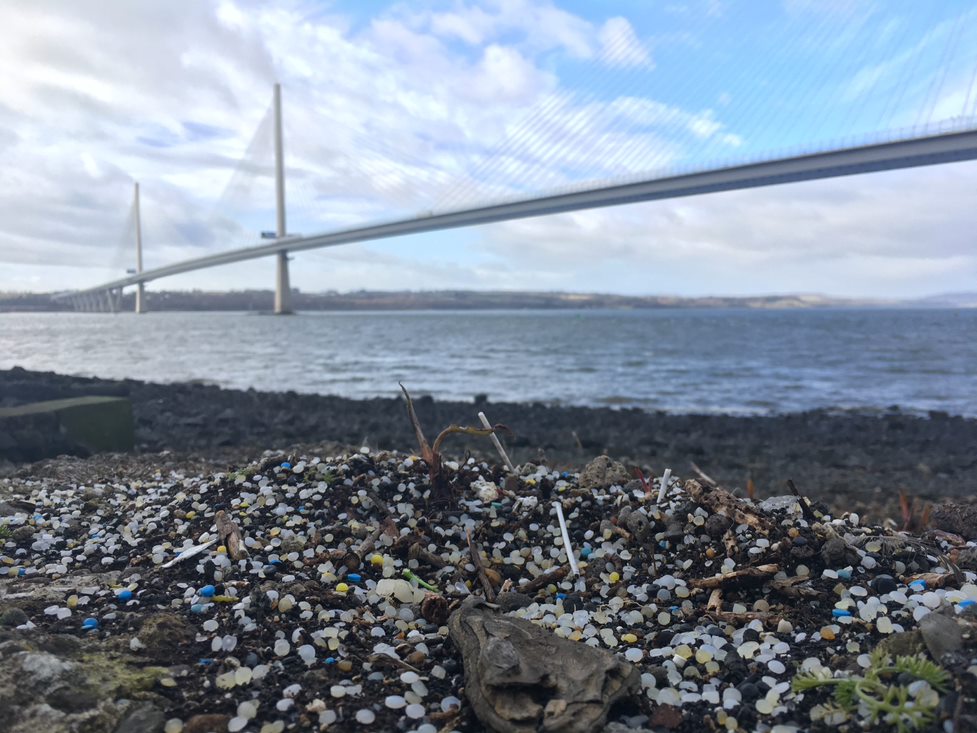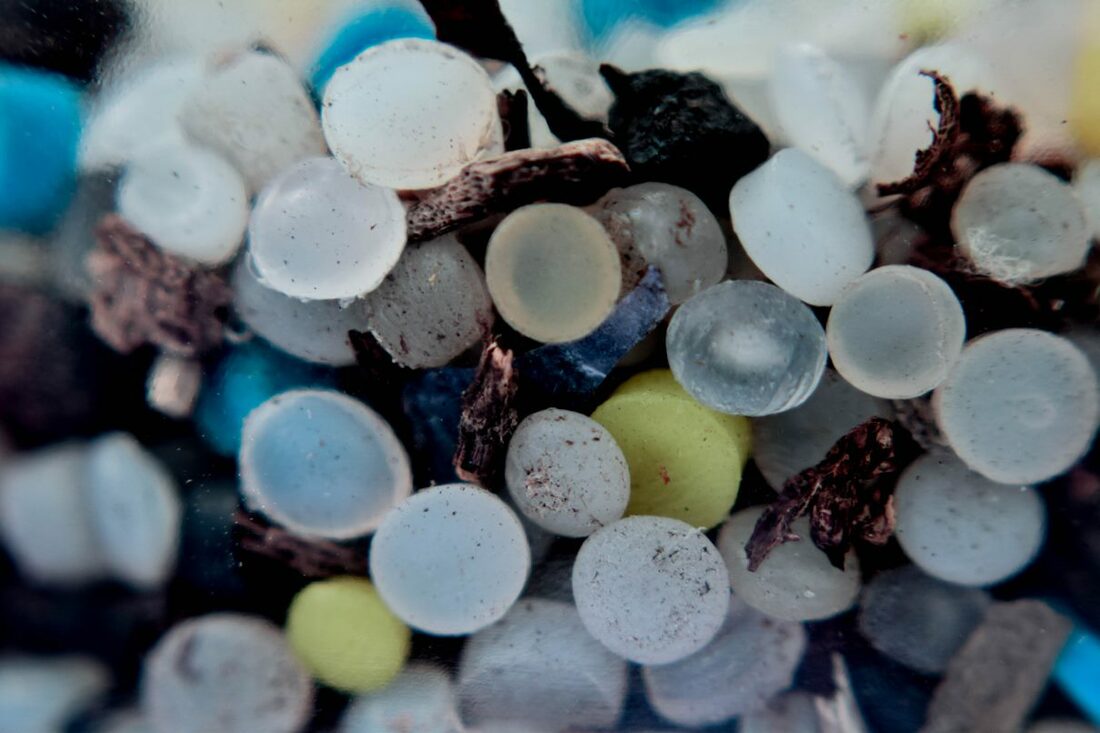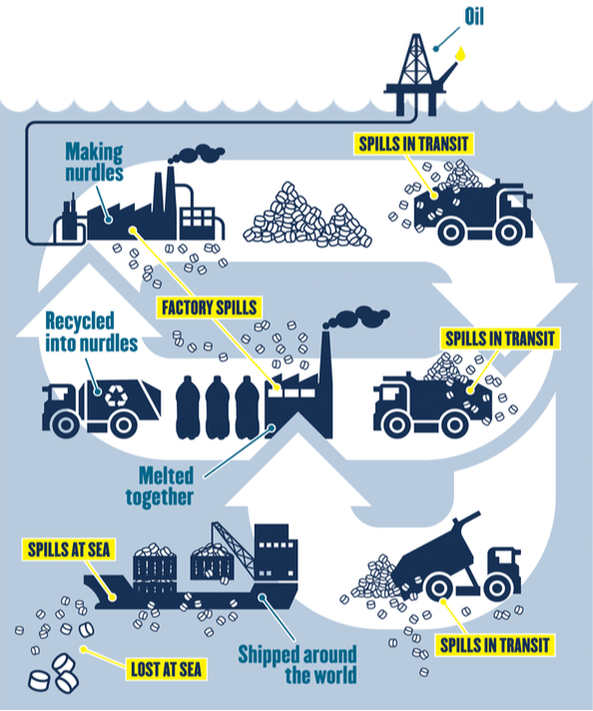Global plastic pollution: the impact of ‘nurdles’
Plastic pollution has risen exponentially since the material entered widespread use in the 1950s. By 2015, global production had increased to 322 million metric tons per year (1) and 8 million tons are estimated to enter our oceans annually (2). Fidra is an environmental charity working with retailers, industry and the scientific community to reduce plastic waste and pollution in our seas. They focus on a source of pollution that is relevant to almost all plastic products: pre-production plastic pellets, also known as “nurdles”.
Plastic pellets, powders and flakes are used to make virtually all our plastic products. These microplastics, usually around 2-3 mm in size, are found on beaches worldwide. In the marine environment they look like fish eggs, and thus are frequently consumed by marine wildlife, including puffins (3), the common gull (4) and fulmars (5). Once trapped in their stomach, the pellets inhibit appetite and deprive marine species of the energy required to forage, grow, reproduce, and avoid predation (6).
Pellets are used as an indicator of seawater pollution levels around the globe (7). Persistent organic pollutants (POPs) from the surrounding seawater adsorb onto the surface of pellets, concentrating toxins to levels millions of times higher than surrounding water (8). In addition, chemical additives used during manufacturing, such as plasticisers, flame retardants and colourants, can leach out into seawater (9), from where they may be absorbed by marine species before or after ingestion (10–12). Pollutants concentrate up the food chain and impact the health of marine wildlife (13).
|
In 1990, the American Chemistry Council and the Plastics Industry Association (formerly SPI) created a scheme called Operation Clean Sweep that encourages companies to identify areas at risk of spills and apply best practice measures to achieve zero pellet, powder and flake loss into the environment. Spills can happen wherever pellets are handled – from production to storage to recycling facilities, at loading tankers or transport containers. Spilt pellets can then enter drainage systems or get washed into nearby waterways by wind and rain, ultimately ending up in our oceans. Spills not only impact the environment: they also decease operational efficiency, cause slips and falls, and affect sustainability.
Operation Clean Sweep is now endorsed by The British Plastics Association and Plastics Europe, and information may be found on the British Plastics Federation website (13). |
However, whilst some companies have made significant strides to manage this problem, across the board uptake of the scheme has been low. Furthermore, it does not grant companies the opportunity to demonstrate their efforts to customers. As such, Fidra is advocating the use of standards and certifications to improve traceability and transparency along the supply chain. This would not only boost uptake of best practice, but also provide the customer with the confidence that the pellets, powders or flakes used to make their plastic product have been handled responsibly at every stage. This approach is supported by industry representatives from across the plastics supply chain.
Fidra is currently in consultation with stakeholders designing a solution fit for purpose. For more information on Fidra’s work or to get involved, please contact [email protected].
Fidra also runs The Great Nurdle Hunt project (14).
References
Fidra is currently in consultation with stakeholders designing a solution fit for purpose. For more information on Fidra’s work or to get involved, please contact [email protected].
Fidra also runs The Great Nurdle Hunt project (14).
References
- https://ourworldindata.org/plastic-pollution
- Jambeck, J.R., et al. (2015) Plastic waste inputs from land into the ocean. Science 347.6223: 768-771.
- Harris M.P., Wanless S. (1994), Ingested elastic and other artifacts found in puffins in Britain over a 24-year period, Marine Pollution Bulletin. 5: Issue 3, 44-46.
- Robards M.D., Piatt J.F., Wohls K.D. (1995), Increasing frequency of plastic particles ingested by seabirds in the subarctic north Pacific, Marine Pollution Bulletin, 30(2), 151-157.
- Van Franeker, J. A., & Law, K. L. (2015). Seabirds, gyres and global trends in plastic pollution. Environmental Pollution, 203, 89-96.
- Derraik (2002) The Pollution of the marine environment by plastic debris: a review, Marine Pollution Bulletin, 44, 842-952.
- Pellet Watch www.pelletwatch.org
- Mato, Y., Isobe, T., Takada, H., Kanehiro, H., Ohtake, C., Kaminuma, T. (2001) Plastic resin pellets as a transport medium for toxic chemicals in the marine environment. Environmental Science and Technology 35, 318–324.
- Gandara e Silva, P.P., Nobre, C.R., Resaffe, P., Pereira, C.D.S., Gusmão, F. (2016) Leachate from microplastics impairs larval development in brown mussels. Water Research 106, 364–370. doi:10.1016/j.watres.2016.10.016
- Nobre, C.R., Santana, M.F., Maluf, A., Cortez, F.S., Cesar, A., Pereira, C.D., Turra, A. (2015) Assessment of microplastic toxicity to embryonic development of the sea urchin Lytechinus variegatus (Echinodermata: Echinoidea), Marine Pollution Bulletin 92(1-2):99-104
- Hamlin, H. J., Marciano, K., & Downs, C. A. (2015). Migration of nonylphenol from food-grade plastic is toxic to the coral reef fish species Pseudochromis fridmani. Chemosphere 139, 223-228.
- Worm, B., Lotze, H.K., Jubinville, I., Wilcox, C., Jambeck, J. (2017) Plastics as a persistent marine pollutant. Annual Review of Environment and Resources Vol. 42:1-26. www.annualreviews.org/doi/abs/10.1146/annurev-environ-102016-060700
- British Plastics Federation www.bpf.co.uk/Sustainability/Operation_Clean_Sweep.aspx
- The Great Nurdles Hunt www.nurdlehunt.org.uk




